Предлоги, обозначающие место (Prepositions of Place)
Предлоги, описывающие направление (Prepositions of Direction)To
Предлоги, описывающие направление: On (to), In (to)
Сравнение "to" и "toward"
Употребление "onto"
Употребление "into"
Предлог (Preposition) - это служебная часть речи, которая выражает отношения между другими словами в предложении.
Место в предложении
Предлог всегда стоит перед существительным и никогда не ставится перед глаголом.
Под "существительным" мы понимаем:
- существительное (dog, money, love)
- имя собственное (Bangkok, Mary)
- местоимение (you, him, us)
- именное словосочетание (my first job)
- герундий (swimming)
После предлога нельзя ставить глагол. Если мы всё-таки хотим это сделать, нужно использовать "-ing" форму, которая на самом деле является герундием или отглагольным существительным.
Примеры употребления предлогов:
| Подлежащее + глагол |
предлог |
"существительное" |
| The food is |
on |
the table. |
| She lives |
in |
Japan. |
| Tara is looking |
for |
you. |
| The letter is |
under |
your blue book. |
| Pascal is used |
to |
English people. |
| She isn't used |
to |
working. |
| I ate |
before |
coming. |
Предлоги, обозначающие место (Prepositions of Place)
at, in, on
Обычно мы используем:
- at для указания на ТОЧКУ в пространстве
- in для указания на ЗАМКНУТОЕ ПРОСТРАНСТВО
- on для указания на ПОВЕРХНОСТЬ
| at |
in |
on |
| ТОЧКА |
ЗАМКНУТОЕ ПРОСТРАНСТВО |
ПОВЕРХНОСТЬ |
| at the corner |
in the garden |
on the wall |
| at the bus stop |
in London |
on the ceiling |
| at the door |
in France |
on the door |
| at the top of the page |
in a box |
on the cover |
| at the end of the road |
in my pocket |
on the floor |
| at the entrance |
in my wallet |
on the carpet |
| at the crossroads |
in a building |
on the menu |
| at the entrance |
in a car |
on a page |
Примеры:
- Jane is waiting for you at the bus stop.
- The shop is at the end of the street.
- My plane stopped at Dubai and Hanoi and arrived in Bangkok
two hours late.
- When will you arrive at the office?
- Do you work in an office?
- I have a meeting in New York.
- Do you live in Japan?
- Jupiter is in the Solar System.
- The author's name is on the cover of the book.
- There are no prices on this menu.
- You are standing on my foot.
- There was a "no smoking" sign on the wall.
- I live on the 7th floor at 21 Oxford Street in
London.
Обратите внимание на часто употребляемые словосочетания с предлогами at, in и
on :
| at |
in |
on |
БЕЗ ПРЕДЛОГА |
| at home |
in a car |
on a bus |
downstairs |
| at work |
in a taxi |
on a train |
downtown |
| at school |
in a helicopter |
on a plane |
inside |
| at university |
in a boat |
on a ship |
outside |
| at college |
in a lift (elevator) |
on a bicycle, on a motorbike |
upstairs |
| at the top |
in the newspaper |
on a horse, on an elephant |
uptown |
| at the bottom |
in the sky |
on the radio, on television |
|
| at the side |
in a row |
on the left, on the right |
|
| at reception |
in Oxford Street |
on the way |
|
Предлоги, описывающие направление: To, On (to), In (to)
При статическом описании предлоги, опсывающие местоположение, часто путают с предлогами, описывающими направление. Эта группа предлогов также может быть использована в описании для обозначения постоянных или свойств или чего-то, происходящего в фиксированный момент.
To, into, и onto соответствуют предлогам места at, in, and on. Каждая пара относится к одному и тому же описанию пространственных отношений: точка, линия/поверхность, область/объём.
1. Основной предлог направления - это "to."
TO: означает ориентацию на цель
Когда это цель физическая, например, место назначения (destination), "to" подразумевает движение в направлении цели.
| Sa'id returned to
his apartment. |
 |
Когда цель является не физическим местом а, например, действием, "to"
является частицей перед инфинитивом и может переводиться словом "чтобы" (in order).
Li Ling washed her dog (in order) to
rid it of fleas.
Оба случая употребления "to" могут встретиться в одном предложении:
2. Два других предлога направления являются составными, образованными путём добавления
"to" к соответствующим предлогам места.
Предлог места задаёт значение предлога направления.
| ON + TO = onto: означает движение к поверхности
|
 |
| IN + TO = into: означает движение
к внутренней части объёма |
 |
3. Со многими глаголами движения "on" и "in" имеют значение предлогов направления
и могут быть использованы в значении "onto" и "into".
| Tai-shing jumped in/into
the pool. |
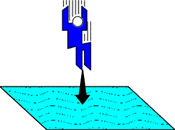 |
| Porfirio fell on/onto
the floor. |
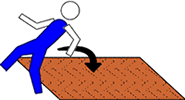 |
| The crab washed up on/onto
the shore. |
 |
Пары этих предлогов до некоторой степени различаются: составной предлог обозначает
завершение действия, а простой указывает на положение предмета в результате этого действия.
Таким образом, предлоги места и направления находятся в отношении "причина/следствие".
| завершение действия |
|
положение предмета |
|
| Jean fell on(to)
the floor. |
 |
Jean is on the floor.
|
 |
| Susumu dived in(to)
the water. |
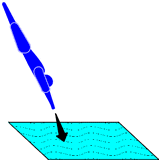 |
Susumu is in the water. |
 |
Сравнение "to" и "toward"
Эти предлоги могут заменять друг друга. Тем не менее, "to" предполагает движение к конкретной цели, а "toward" - движение в каком-то направлении, то есть, достижение цели не является обязательным.
| Drive toward
the city limits and turn north. |
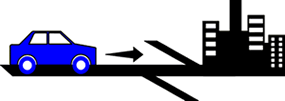
(Drive in the direction of the city limits; turnoff may be before arriving
there.)
|
The plane was headed toward a
mountain. |

(It was headed in the direction of a mountain; it may not have reached
or hit the mountain.)
|
Take me to the airport, please.
|

(I actually want to arrive at the airport.)
|
Употребление "onto"
1. "Onto" можно заменять предлогом "on" с глаголами движения .
| Dietrich jumped on(to)
the mat. |
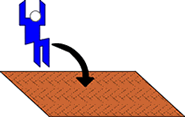 |
| Huan fell on(to)
the floor. |
 |
(18) Athena climbed on(to) the back
of the truck. |
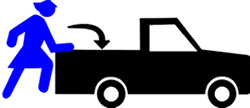 |
2. Некоторые глаголы движения выражают идею, что в результате воздействия предмета, он сам или другой предмет оказался в определённом месте.
После таких глаголов в некоторых случаях употребляется только "on". После остальных глаголов можно употреблять оба предлога.
The plane landed on the runway.
(not onto the runway)
Sam hung the decoration on the Christmas
tree. (not onto the tree)
He placed the package on the table.
(not onto the table)
Joanna spilled her Coke on the rug.
(not onto the rug)
Samir moved the chair on(to) the
deck.
The crane lowered the roof on(to)
the house.
The baby threw the pot on(to) the
floor.
Глаголы, после которых употребляется только "on" встречаются редко: помимо указанных в примерах, - "to set" и "to put".
Глаголы, после которых можно употреблять оба предлога: "to raise", "to scatter", "to pour", "to add".
The farmer scattered seed on(to)
the fertile ground.
We're adding on a wing at the back
of the building.
We're adding a porch onto the house.
Употребление "into"
1. C глаголами движения "into" и "in" взаимозаменяемы, за исключением тех случаев, когда
предлог является последним словом в предложении или стоит непосредственно перед обстоятельством времени, образа действия или частотности.
В этом случае можно употреблять только in (или inside) .
The patient went into the doctor's
office.
The patient went in. (not into)
Our new neighbors moved into the
house next door yesterday. ('to take up residence in a new home')
Our new neighbors moved in yesterday.
В вопросительных предложениях "into" тоже может быть последним словом.
Now what kind of trouble has she gotten herself into?
Now what sort of trouble is she in?
2. Глаголы, обозначающие стационарное положение, употребляются только с предлогом "on" или "in"
в их обычном значении.
Если глагол позволяет, то дополнение, следующее после предлога можно опустить. Тогда конструкция может иметь идиоматический смысл.
| The cat sat on
the mat. |
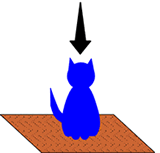 |
| The doctor is in
his office. |
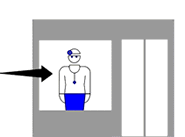 |
| The doctor is in.
('available for consultation') |
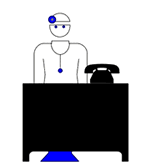 |
У предлога "In(to)" есть два особенных значения при описании движения.
3. Когда после "move in" следует придаточное цели, он имеет значение
"приближения".
The lion moved in for the kill.
The police moved in to rescue the
hostages inside the building.
В примерах "in" - это часть глагола, поэтому "into" в этих случаях употреблять нельзя; мы не можем сказать: "The lion moved into for the kill."
4. Когда "into" используется с "move", он функционирует как обычный предлог, передающий идею передвижения чего-либо с одного места на другое.
| We'll move your brother's old bed into
your room. |
|
Посмотрите, как предлоги места и направления использованы в тексте для описания стола преподавателя.
You can sit before the desk (or in front of the desk). The professor can sit on the desk (when he's being informal) or behind the desk, and then his feet are under the desk or beneath the desk. He can stand beside the desk (meaning next to the desk), before the desk, between the desk and you, or even on the desk (if he's really strange). If he's clumsy, he can bump into the desk or try to walk through the desk (and stuff would fall off the desk). Passing his hands over the desk or resting his elbows upon the desk, he often looks across the desk and speaks of the desk or concerning the desk as if there were nothing else like the desk. Because he thinks of nothing except the desk, sometimes you wonder about the desk, what's in the desk, what he paid for the desk, and if he could live without the desk. You can walk toward the desk, to the desk, around the desk, by the desk, and even past the desk while he sits at the desk or leans against the desk.
Использованные ресурсы:
Purdue University Online Writing Lab
http://www.better-english.com/grammar/prepositions.htm
http://www.eslpartyland.com/quiz%20center/preploc.htm
далее: - Основные английские предлоги места и направления с переводом на русский язык
|